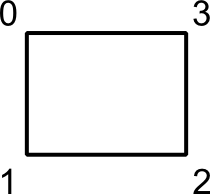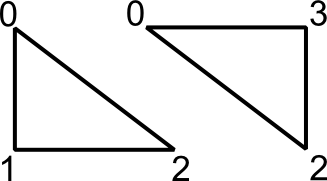| Top |
Vertex BuffersVertex Buffers — An API for submitting extensible arrays of vertex attributes to be mapped into the GPU for fast drawing. |
Functions
| CoglHandle | cogl_vertex_buffer_new () |
| unsigned int | cogl_vertex_buffer_get_n_vertices () |
| void | cogl_vertex_buffer_add () |
| void | cogl_vertex_buffer_delete () |
| void | cogl_vertex_buffer_submit () |
| void | cogl_vertex_buffer_disable () |
| void | cogl_vertex_buffer_enable () |
| void | cogl_vertex_buffer_draw () |
| CoglBool | cogl_is_vertex_buffer () |
| CoglHandle | cogl_vertex_buffer_indices_new () |
| void | cogl_vertex_buffer_draw_elements () |
| CoglHandle | cogl_vertex_buffer_indices_get_for_quads () |
| CoglBool | cogl_is_vertex_buffer_indices () |
Description
For example to describe a textured triangle, you could create a new cogl vertex buffer with 3 vertices, and then you might add 2 attributes for each vertex:
- a "gl_Position" describing the (x,y,z) position for each vertex.
- a "gl_MultiTexCoord0" describing the (tx,ty) texture coordinates for each vertex.
The Vertex Buffer API is designed to be a fairly raw mechanism for developers to be able to submit geometry to Cogl in a format that can be directly consumed by an OpenGL driver and mapped into your GPU for fast re-use. It is designed to avoid repeated validation of the attributes by the driver; to minimize transport costs (e.g. considering indirect GLX use-cases) and to potentially avoid repeated format conversions when attributes are supplied in a format that is not natively supported by the GPU.
Although this API does allow you to modify attributes after they have been submitted to the GPU you should be aware that modification is not that cheap, since it implies validating the new data and potentially the OpenGL driver will need to reformat it for the GPU.
If at all possible think of tricks that let you re-use static attributes, and if you do need to repeatedly update attributes (e.g. for some kind of morphing geometry) then only update and re-submit the specific attributes that have changed.
Functions
cogl_vertex_buffer_new ()
CoglHandle
cogl_vertex_buffer_new (unsigned int n_vertices);
cogl_vertex_buffer_new has been deprecated since version 1.16 and should not be used in newly-written code.
Use the CoglPrimitive api instead
Creates a new vertex buffer that you can use to add attributes.
cogl_vertex_buffer_get_n_vertices ()
unsigned int
cogl_vertex_buffer_get_n_vertices (CoglHandle handle);
cogl_vertex_buffer_get_n_vertices has been deprecated since version 1.16 and should not be used in newly-written code.
Use the CoglPrimitive api instead
Retrieves the number of vertices that handle
represents
cogl_vertex_buffer_add ()
void cogl_vertex_buffer_add (CoglHandle handle,const char *attribute_name,uint8_t n_components,CoglAttributeType type,CoglBool normalized,uint16_t stride,const void *pointer);
cogl_vertex_buffer_add has been deprecated since version 1.16 and should not be used in newly-written code.
Use the CoglPrimitive api instead
Adds an attribute to a buffer, or replaces a previously added attribute with the same name.
You either can use one of the built-in names such as "gl_Vertex", or "gl_MultiTexCoord0" to add standard attributes, like positions, colors and normals, or you can add custom attributes for use in shaders.
The number of vertices declared when calling cogl_vertex_buffer_new()
determines how many attribute values will be read from the supplied
pointer
.
The data for your attribute isn't copied anywhere until you call
cogl_vertex_buffer_submit(), or issue a draw call which automatically
submits pending attribute changes. so the supplied pointer must remain
valid until then. If you are updating an existing attribute (done by
re-adding it) then you still need to re-call cogl_vertex_buffer_submit()
to commit the changes to the GPU. Be carefull to minimize the number
of calls to cogl_vertex_buffer_submit(), though.
|-0-0-0-0-0-0-0-0-0-0|This is not ok:
|- - - - -0-0-0-0-0-0 0 0 0 0|(Though you can have multiple groups of interleved attributes)
Parameters
handle |
A vertex buffer handle |
|
attribute_name |
The name of your attribute. It should be a valid GLSL variable name and standard attribute types must use one of following built-in names: (Note: they correspond to the built-in names of GLSL)
To support adding multiple variations of the same attribute the name can have a detail component, E.g. "gl_Color::active" or "gl_Color::inactive" |
|
n_components |
The number of components per attribute and must be 1, 2, 3 or 4 |
|
type |
a CoglAttributeType specifying the data type of each component. |
|
normalized |
If |
|
stride |
This specifies the number of bytes from the start of one attribute value to the start of the next value (for the same attribute). So, for example, with a position interleved with color like this: XYRGBAXYRGBAXYRGBA, then if each letter represents a byte, the stride for both attributes is 6. The special value 0 means the values are stored sequentially in memory. |
|
pointer |
This addresses the first attribute in the vertex array. This
must remain valid until you either call |
cogl_vertex_buffer_delete ()
void cogl_vertex_buffer_delete (CoglHandle handle,const char *attribute_name);
cogl_vertex_buffer_delete has been deprecated since version 1.16 and should not be used in newly-written code.
Use the CoglPrimitive api instead
Deletes an attribute from a buffer. You will need to call
cogl_vertex_buffer_submit() or issue a draw call to commit this
change to the GPU.
cogl_vertex_buffer_submit ()
void
cogl_vertex_buffer_submit (CoglHandle handle);
cogl_vertex_buffer_submit has been deprecated since version 1.16 and should not be used in newly-written code.
Use the CoglPrimitive api instead
Submits all the user added attributes to the GPU; once submitted, the attributes can be used for drawing.
You should aim to minimize calls to this function since it implies validating your data; it potentially incurs a transport cost (especially if you are using GLX indirect rendering) and potentially a format conversion cost if the GPU doesn't natively support any of the given attribute formats.
cogl_vertex_buffer_disable ()
void cogl_vertex_buffer_disable (CoglHandle handle,const char *attribute_name);
cogl_vertex_buffer_disable has been deprecated since version 1.16 and should not be used in newly-written code.
Use the CoglPrimitive api instead
Disables a previosuly added attribute.
Since it can be costly to add and remove new attributes to buffers; to make individual buffers more reuseable it is possible to enable and disable attributes before using a buffer for drawing.
You don't need to call cogl_vertex_buffer_submit() after using this
function.
cogl_vertex_buffer_enable ()
void cogl_vertex_buffer_enable (CoglHandle handle,const char *attribute_name);
cogl_vertex_buffer_enable has been deprecated since version 1.16 and should not be used in newly-written code.
Use the CoglPrimitive api instead
Enables a previosuly disabled attribute.
Since it can be costly to add and remove new attributes to buffers; to make individual buffers more reuseable it is possible to enable and disable attributes before using a buffer for drawing.
You don't need to call cogl_vertex_buffer_submit() after using this function
cogl_vertex_buffer_draw ()
void cogl_vertex_buffer_draw (CoglHandle handle,CoglVerticesMode mode,int first,int count);
cogl_vertex_buffer_draw has been deprecated since version 1.16 and should not be used in newly-written code.
Use the CoglPrimitive api instead
Allows you to draw geometry using all or a subset of the vertices in a vertex buffer.
Any un-submitted attribute changes are automatically submitted before drawing.
Parameters
handle |
A vertex buffer handle |
|
mode |
A CoglVerticesMode specifying how the vertices should be interpreted. |
|
first |
Specifies the index of the first vertex you want to draw with |
|
count |
Specifies the number of vertices you want to draw. |
cogl_is_vertex_buffer ()
CoglBool
cogl_is_vertex_buffer (CoglHandle handle);
cogl_is_vertex_buffer has been deprecated since version 1.16 and should not be used in newly-written code.
Use the CoglPrimitive api instead
Checks whether handle
is a Vertex Buffer Object
Since: 1.0
cogl_vertex_buffer_indices_new ()
CoglHandle cogl_vertex_buffer_indices_new (CoglIndicesType indices_type,const void *indices_array,int indices_len);
cogl_vertex_buffer_indices_new has been deprecated since version 1.16 and should not be used in newly-written code.
Use the CoglPrimitive api instead
Depending on how much geometry you are submitting it can be worthwhile optimizing the number of redundant vertices you submit. Using an index array allows you to reference vertices multiple times, for example during triangle strips.
Parameters
indices_type |
a CoglIndicesType specifying the data type used for the indices. |
|
indices_array |
Specifies the address of your array of indices. |
[array length=indices_len] |
indices_len |
The number of indices in indices_array |
cogl_vertex_buffer_draw_elements ()
void cogl_vertex_buffer_draw_elements (CoglHandle handle,CoglVerticesMode mode,CoglHandle indices,int min_index,int max_index,int indices_offset,int count);
cogl_vertex_buffer_draw_elements has been deprecated since version 1.16 and should not be used in newly-written code.
Use the CoglPrimitive api instead
This function lets you use an array of indices to specify the vertices
within your vertex buffer that you want to draw. The indices themselves
are created by calling cogl_vertex_buffer_indices_new()
Any un-submitted attribute changes are automatically submitted before drawing.
Parameters
handle |
A vertex buffer handle |
|
mode |
A CoglVerticesMode specifying how the vertices should be interpreted. |
|
indices |
A CoglHandle for a set of indices allocated via
|
|
min_index |
Specifies the minimum vertex index contained in indices |
|
max_index |
Specifies the maximum vertex index contained in indices |
|
indices_offset |
An offset into named indices. The offset marks the first index to use for drawing. |
|
count |
Specifies the number of vertices you want to draw. |
cogl_vertex_buffer_indices_get_for_quads ()
CoglHandle
cogl_vertex_buffer_indices_get_for_quads
(unsigned int n_indices);
cogl_vertex_buffer_indices_get_for_quads has been deprecated since version 1.16 and should not be used in newly-written code.
Use the CoglPrimitive api instead
Creates a vertex buffer containing the indices needed to draw pairs
of triangles from a list of vertices grouped as quads. There will
be at least n_indices
entries in the buffer (but there may be
more).
The indices will follow this pattern:
0, 1, 2, 0, 2, 3, 4, 5, 6, 4, 6, 7 ... etc
For example, if you submit vertices for a quad like like that shown in Figure 2, “Example of vertices submitted to form a quad” then you can request 6 indices to render two triangles like those shown in Figure 3, “Illustration of the triangle indices that will be generated”.
Returns
A CoglHandle containing the indices. The handled is
owned by Cogl and should not be modified or unref'd.
cogl_is_vertex_buffer_indices ()
CoglBool
cogl_is_vertex_buffer_indices (CoglHandle handle);
cogl_is_vertex_buffer_indices has been deprecated since version 1.16 and should not be used in newly-written code.
Use the CoglPrimitive api instead
Checks whether handle
is a handle to the indices for a vertex
buffer object
Since: 1.4
Types and Values
enum CoglVerticesMode
Different ways of interpreting vertices when drawing.
Members
|
FIXME, equivalent to GL_POINTS
|
||
|
FIXME, equivalent to |
||
|
FIXME, equivalent to GL_LINE_LOOP
|
||
|
FIXME, equivalent to GL_LINE_STRIP
|
||
|
FIXME, equivalent to GL_TRIANGLES
|
||
|
FIXME, equivalent to GL_TRIANGLE_STRIP
|
||
|
FIXME, equivalent to |
Since: 1.0
enum CoglIndicesType
You should aim to use the smallest data type that gives you enough range, since it reduces the size of your index array and can help reduce the demand on memory bandwidth.
Note that COGL_INDICES_TYPE_UNSIGNED_INT is only supported if the
COGL_FEATURE_ID_UNSIGNED_INT_INDICES feature is available. This
should always be available on OpenGL but on OpenGL ES it will only
be available if the GL_OES_element_index_uint extension is
advertized.


